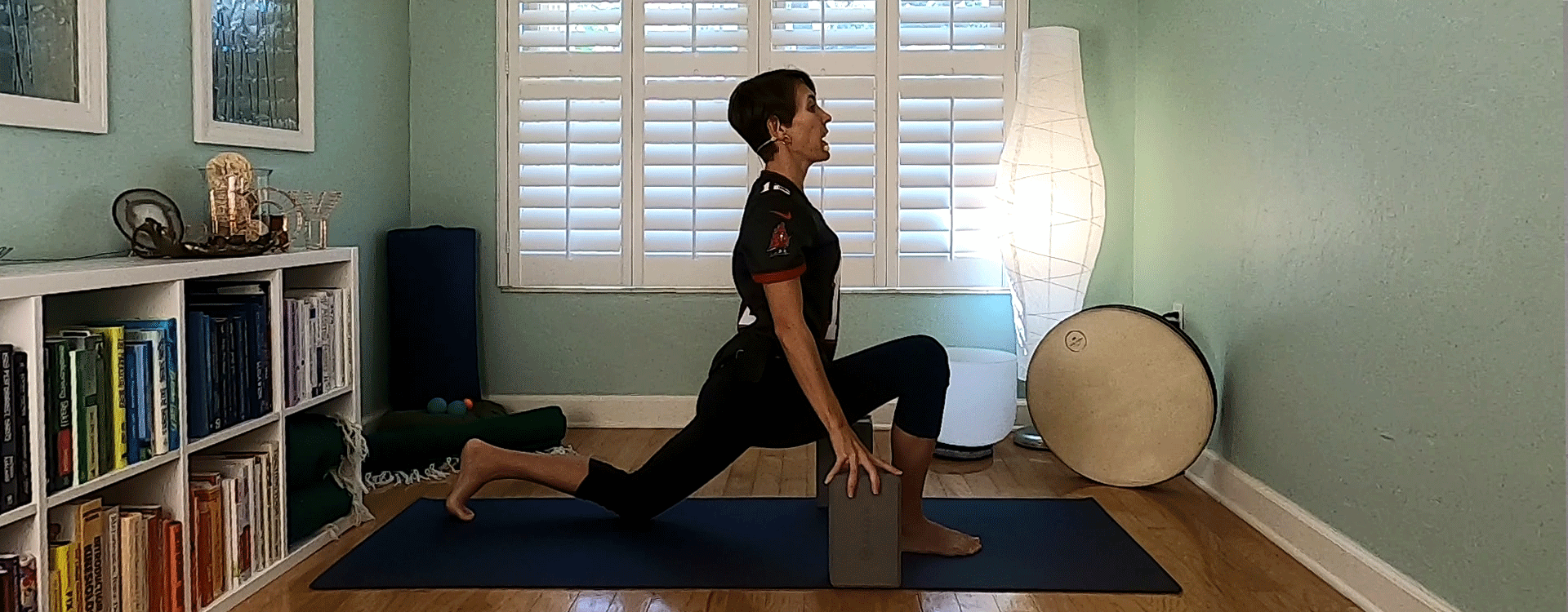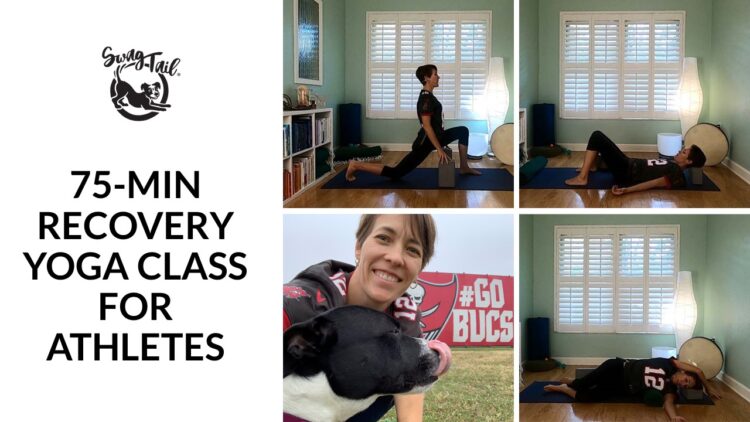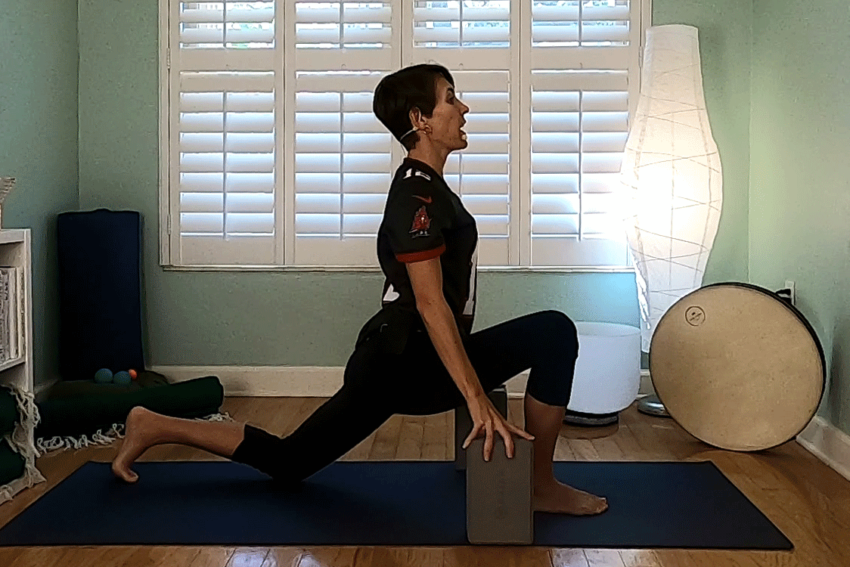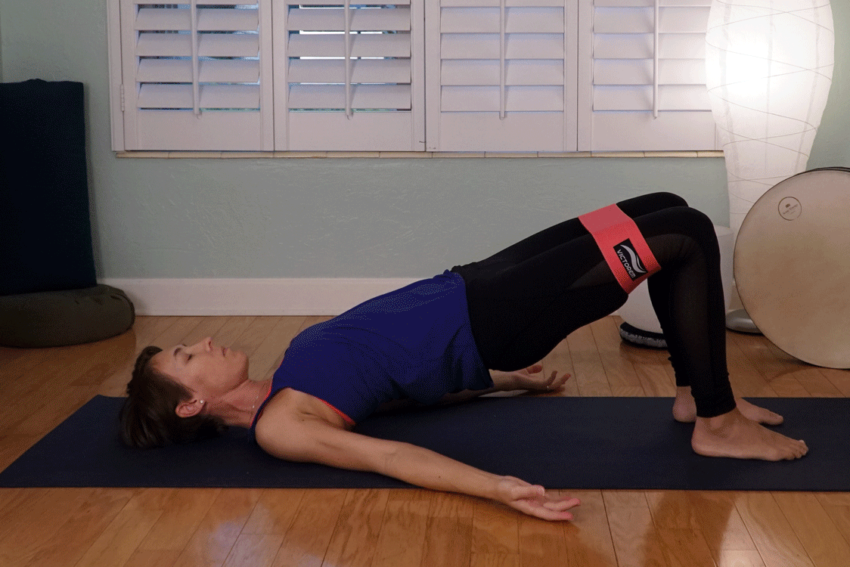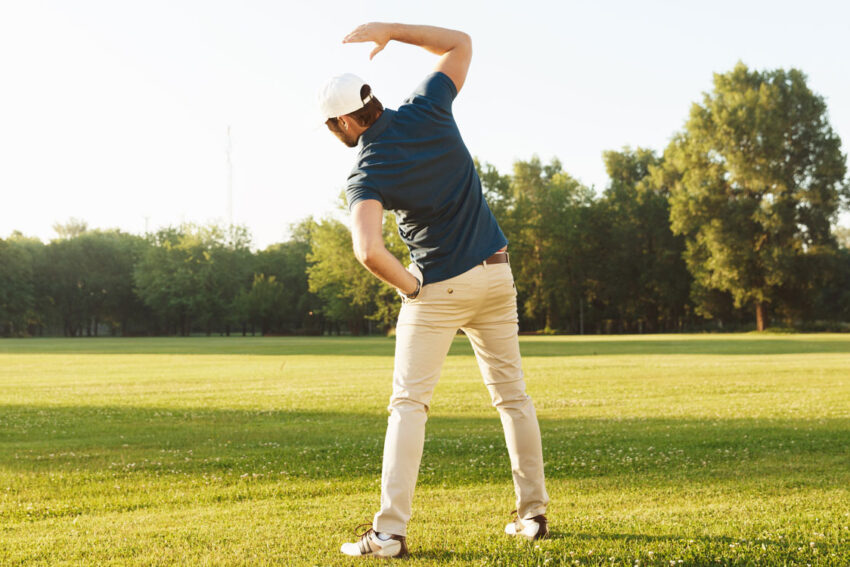There are times in life that require intense physical or mental focus. This can happen in daily life, and it most definitely happens in sports. In either case, your sympathetic nervous system often dominates to increase performance. This is great in competition. Yet if you stay in this state, unwanted symptoms of chronic stress can surface. That’s why I created this post-game recovery yoga class for golfers. You’ll replenish the body, calm the mind, and get on track internally so you can train and play better in the future.
One concept comes to mind as I’m writing this: The higher your intensity level during play, or the more intense the level of play, the more important recovery is.
Since we just hosted and won Super Bowl 55 here last weekend, my mind has been obsessed with sports. Tom Brady, whom I refer to in our house as the machine, came to the Buccaneers only a year ago. He helped turn the team around. He inspired his fellow teammates. Brady also demonstrated how deliberate training can take you to greater heights.
Now, after the hard work of winning has been accomplished, it’s time to rest. This is the recovery cycle for athletes. The yoga sequence below is one you can use as an athlete yourself, or after a challenging day to get the same benefits that professional football players would as well.
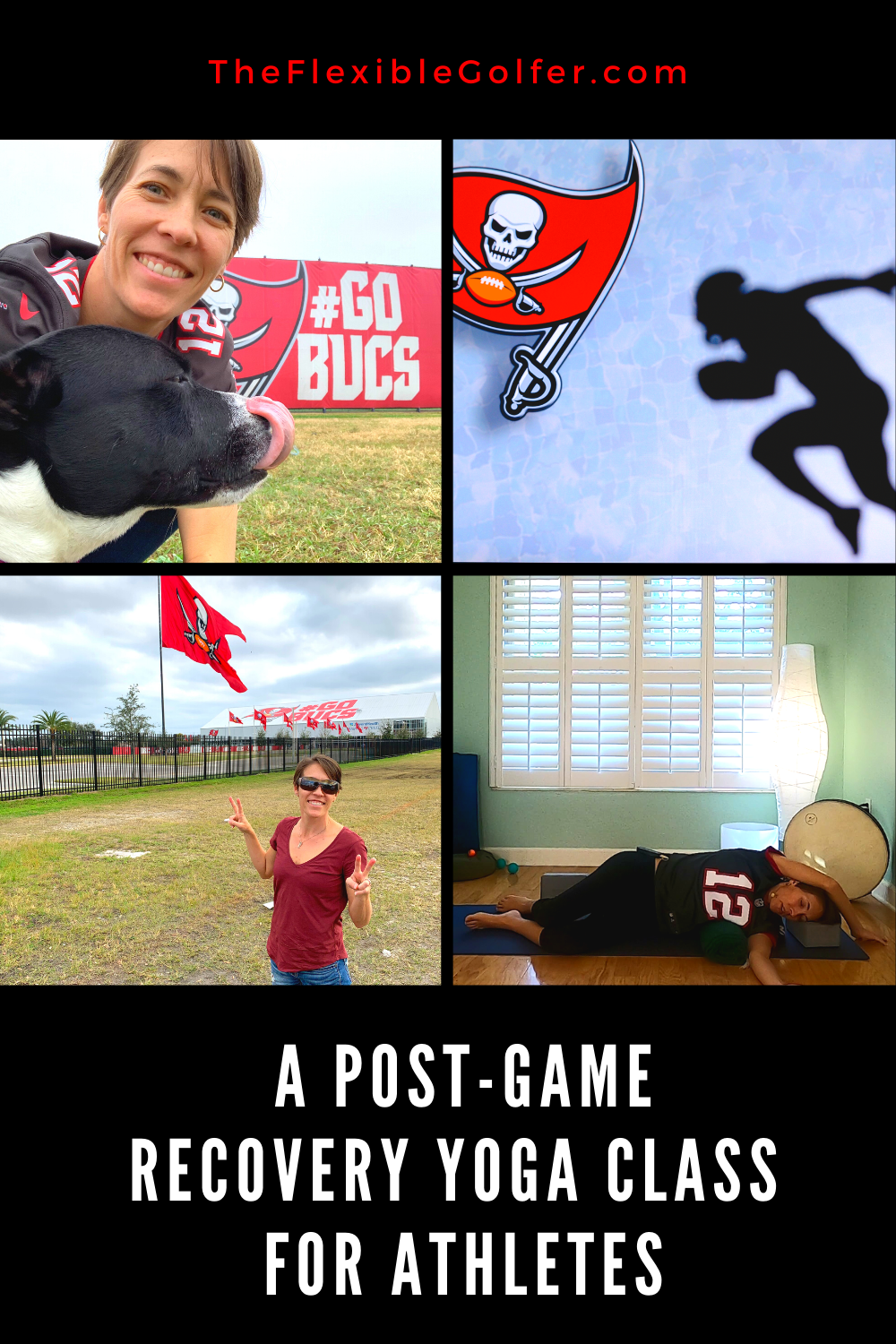
PHASES OF ADAPTATION
When you undergo hard training, or competition in your sport, there are four phases of adaptation that occur once you’re done. Ideally, we want to use yoga appropriately to support yourself and your athletes in each stage. Here is a summary of all four phases again:
Fatigue (0-2 hrs after event)
In this stage, neural activation is reduced and muscle glycogen stores are depleted. Mental fatigue can also be present (since so much energy was used to focus during your sport). Also, the sympathetic nervous system is still dominant and cortisol levels are high. Passive, static stretching on the floor can help remove inflammation or swelling from training. Pranayama and meditation are a great way to downregulate the nervous system, too.
Recovery (1-2 days after)
The recovery yoga class below is great to integrate 24-28 hours after a game or training session. The body does use more energy during this period to restore protein and hormone balance, as well as replenish glycogen stores.
Compensation (24-72 hours)
In this time frame, the body has likely adapted physically and mentally to the new level of fitness. Because your feel stronger, greater training can be applied. This could be a more intense yoga class, like a vinyasa flow, or more sport-specific practice.
Return (3-7 days)
This forth phase is vital for improvement in athletic performance over time. If more training is not applied here, then you lose any gains from previous training activities. A well-rounded yoga class of any style can help keep those neural networks firing (and support better performance in the future).
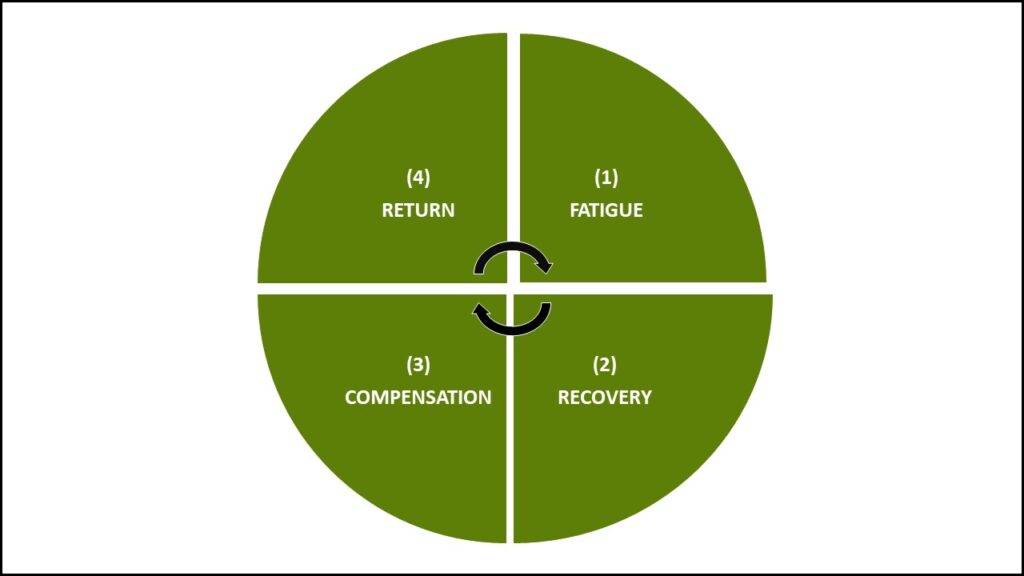
STYLES OF YOGA IN THIS SEQUENCE
In this recovery class specifically, there are a few different yoga styles involved.
- A slow flow style. This is incorporated to help bring the body into stillness. Just as it’s challenging to take a car traveling at 100 mph and bring it to an abrupt stop, we want to slow down your athletic body and mind in a more gradual manner. No slamming on the breaks in this class!
- Myofascial release (MFR). The connective tissue, or fascia, has a superficial layer under the skin and deeper layer as around each organ and muscle (and through the musculature as well). This network helps with your immunity, cellular communication, and rehydration of the body tissues. For these benefits and more—including the release of trigger points—we’ll use MFR in this recovery yoga class for athletes.
- Yin yoga. One of the best ways to modify the fascia is though longer-held postures. In fact, we’ll use yin yoga to offset the asymmetries that can accumulate from your sport. More importantly, you’ll become aware of those imbalances. With that knowledge you can discover which will still serve you as an athlete, and which ones you’ll be ready to remedy via your yoga practice.
Props needed:
For this sequence, you’ll need a few unique props. This includes:
- A tennis ball, or similar-sized myofascial release ball. I suggest the Rad Rounds set.
- A Golf Ball, or the same sized ball from Rad Rounds
- Two blocks
- A rolled blanket or towel or yoga mat
TAKE THE CLASS WITH US NOW
You can read through the sequence below and you can also follow along in this 75-minute class on our YouTube Channel.
(1) MFR FOR THE FEET
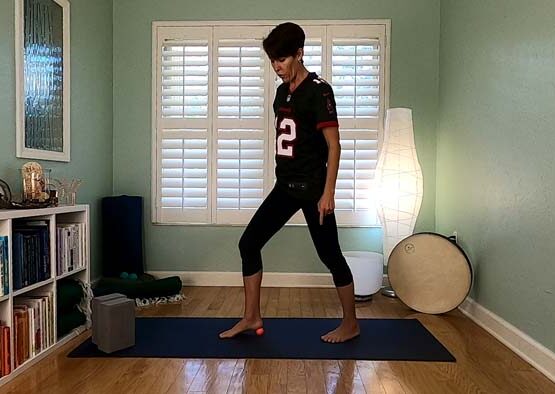
Purpose: Most sports require you to shove your feet in shoes for hours on end. The feet must also support immense weight as you move through various positions. Using myofascial release techniques on the feet at the beginning of this recovery yoga class will offset unwanted tension that accumulates in the feet. And it opens up neurological communication with the rest of the body.
Length: 4-5 minutes each side
Additional Notes:
- a tennis ball or larger MFR ball will make this easier.
- a golf ball or smaller MFR ball will allow you to get into more specific areas that are tight
- If you don’t have a ball, then I suggest doing a few specific movements with the feet, like moving from ball mount to heel. Then, rock your weight to the inner edge and outer edges of the feet respectively. At least this way you can start to test your balance and increase awareness in the feet. Another option is to take a broken toe pose.
Counter pose: use tadasana between sides to observe new sensations in the body
(2) HALF SUN SALUTATIONS
Purpose: The goal of placing half sun salutations second in this recovery yoga class sequence is to address the body as a whole. It’s also symmetrical right to left, which is often not the case in your sport. This increase of communication within the body reinforces the importance of balance, and your time on the mat to restore it now.
Length: 3-4 rounds
Additional Notes: Check out this class online to be walked through the poses in these half sun salutations.
(3) LOW LUNGE AND HALF SPLITS
Purpose: From Tadasana, it’s easy to step your right foot back and take a low lunge. This gentle moving sequence still uses movement to create focus int he mind. And, it targets two larger muscle groups at the same time—the quadriceps and the hamstrings.
Length: move through each pose 5 times
Additional Notes:
- use the inhale to drop the hips and enter low lunge. Exhale to move the hips back in space and straighten the front leg
- keep the hips square to the front edge of the mat the entire time.
- use a block under each hand to bring the floor closer to make this sequence easier.
(4) LIZARD POSE
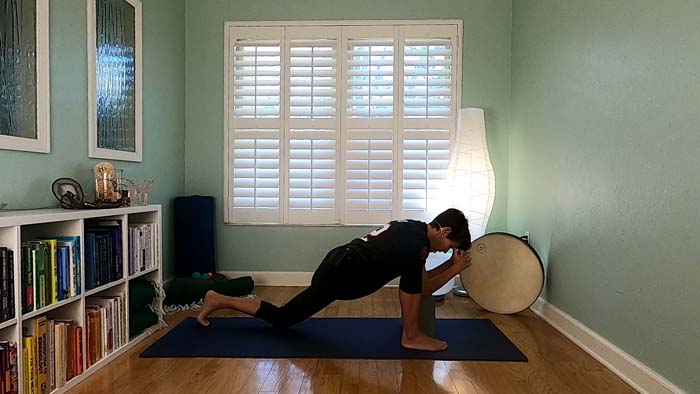
Purpose: This is the first yin-style pose of the sequence and it’s designed to re-lengthen the quadriceps and hip flexors of the back leg. And since you’re only going 50 percent, the body can rest into the pose. And, the connective tissue can rehydrate, release adhesions, and lay down new collagen fibers in an organized fashion. This all leads to increased functionality over time.
Length: Hold for 3-5 minutes
Additional notes:
- flip the fingers back toward the body to get. A wrist stretch.
- place blocks under the hands to make the pose more accessible.
- rest of the forearms to go deeper.
(5) FORWARD FOLD
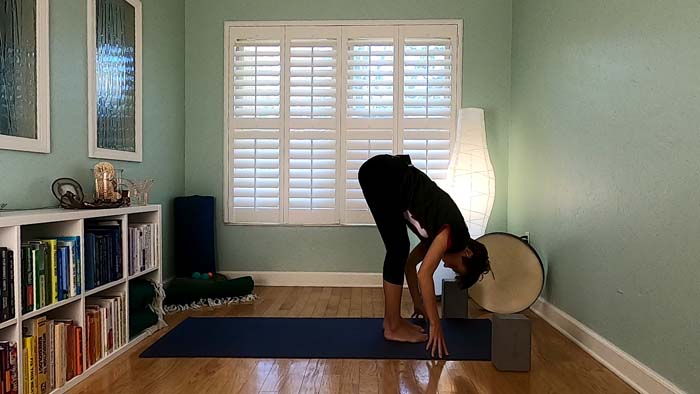
Purpose: The reason uttanana, or a forward fold, follows lizard pose in this recovery yoga class is for two reasons: One it’s symmetrical and it increases the capacity for you to see the difference created between sides after the previous pose. Second, it’s a mild inversion and starts to calm the nervous system.
Length: 2 minutes
Additional Notes:
- bend knees as much as needed here to fold comfortably
- you can reach for opposite elbows and hang in a rag doll position
- add a small roll under the ball mount of your feet to add in a deeper calf stretch
(6) REPEAT STEPS 3-5 ON THE SECOND SIDE
Purpose: Even though your sport might be asymmetrical, we are trying to restore balance to the body with this recovery class. We’ll do this by repeating poses 3-5 on the second side. Keep in mind, though, that if you notice additional tension on one side over the other, you can remain there longer to offset any additional tension.
Length: Same as done on the previous side
(7) MFR FOR THE HIPS
Purpose: The gluteus muscle group is another incredible powerhouse in the body. The gluten give you stability when you walk and power when you run and jump. Using the tennis balls, or Myofascial Release RAD rounds, can release adhesions that accumulate in this region. This can facilitate greater efficiency and coordination within the group and with the rest of the body. Said another way, you can perform better in your sport when these muscles fire appropriately.
Length: 4-5 minutes each side
Additional Notes:
- start on your back in constructive rest pose, both feet on the ground.
- place the ball right in the middle of your right butt cheek and roll around to find a tender spot.
- the weight distribution on your feet help control the pressure. You can roll more to the right if you want a more intense sensation. Or, you can keep your weight more evenly distributed to lessen it. Keep in mind you only need a 50-70 percent sensation to gain immense benefits.
- stay when you find that spot and breathe deeply.
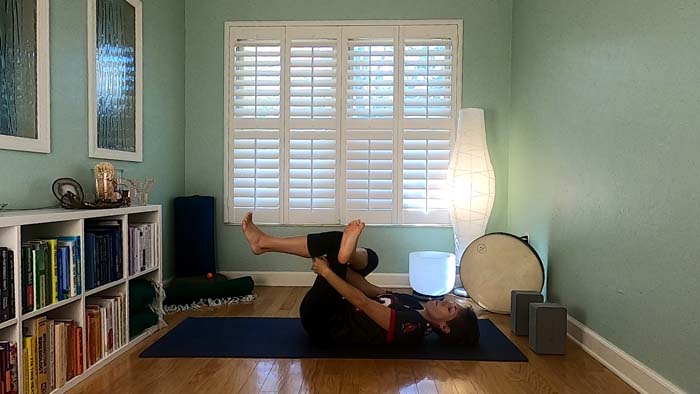
Optional Modification: If you don’t have a tennis ball or MFR rad rounds balll, simple take a reclined figure-4. pose.
(8) RECLINED SPINAL TWIST
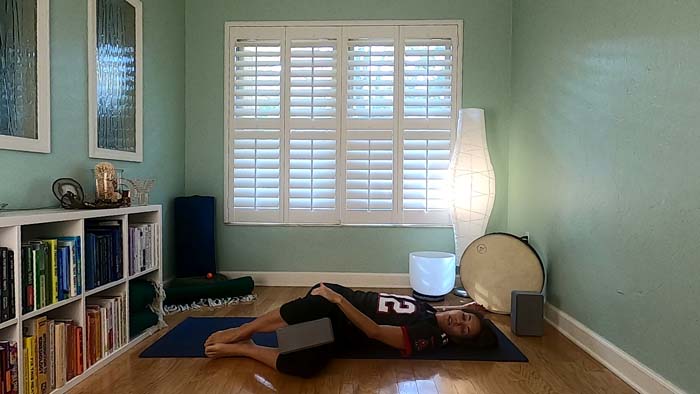
Purpose: This recovery yoga class for athletes has been moving from the feet to the crown of the head. Now we’ll move from releasing tension in the flutes and hips and create space in the low back. This gentle spinal twist will do just that.
Length: 4-5 minutes each side
Additional Notes:
- use a block under or between the knees for support
allow gravity to melt the back of the shoulders toward the ground. Yet do not force them there. - keep your head facing in the direction of your knees to
- deepen the neck strength on the opposite side of the body
(9) SIDE-LYING STRETCH
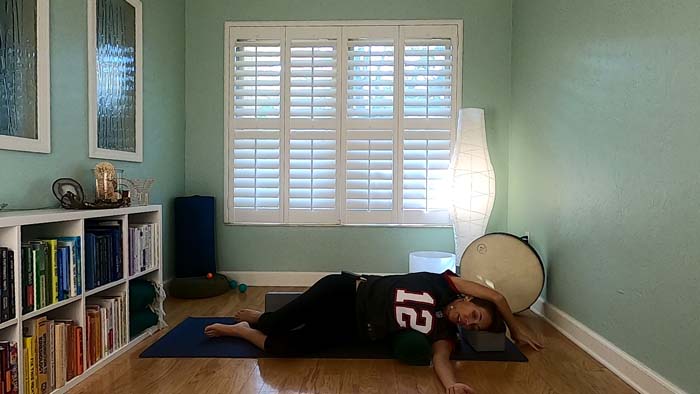
Purpose: From the low back you’ll now elongate the side of the body. Since most sports are asymmetrical, this creates further unwanted imbalances from accumulating. Plus, the pose is very restorative in nature. Your ribs are supported and you can use the contact with that prop to increase your focus in the moment.
Length: 4-5 minutes each side
Additional Notes:
- really lengthen the side body before resting into the pose.
- keep the top arm on your hip if there is any discomfort
- let the head and shoulders get heavier with each cycle of breath.
(10) RECLINED HEART OPENER
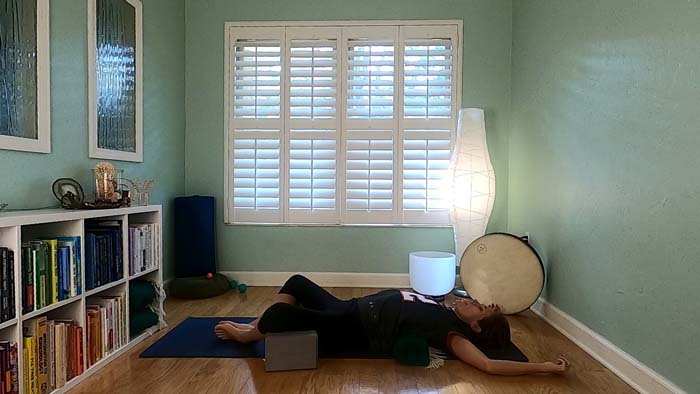
Purpose: With the roll in place from the previous pose, it’s an easy transition into a symmetrical pose to open the heart. Since many sports are forward-moving in nature, the shoulders and pecs can be overused. Said another way, the back can round over time. This, in conjunction with other habitual tendencies throughout the day, can close off the heart. Use this gentle backbend to offset poor posture over time.
Length: 3-6 minutes
Additional Notes:
- find a leg position that’s comfortable. This could be in constructive rest (knees bent, feet on the floor), savasana (legs straight), or even supta baddha konasana (knees bent, soles of the feet together).
- make the roll smaller to lessen the intensity of the stretch. Make it larger to increase it.
- remember to keep the backs of your shoulders on the ground and the neck comfortable while you’re here.
(11) MFR FOR THE NECK
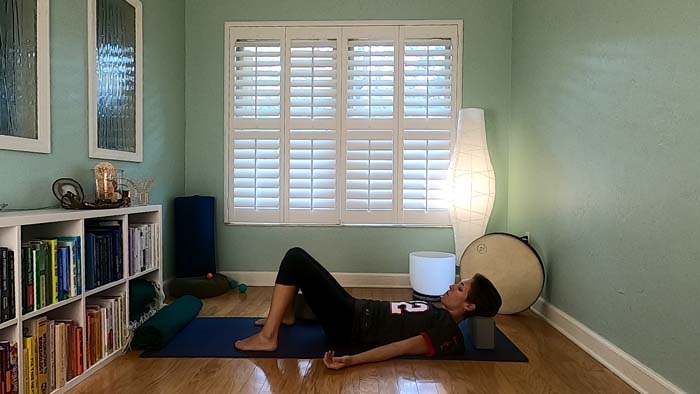
Purpose: The muscles of the neck work hard all day, and especially in your sport, to support the weight of your head. That’s why this recovery yoga class for athletes ends with some gentle myofascial release for the back of the neck.
Length: 5-7 minutes total
Additional Notes:
- Place the corner of the block just below the occipital ridge in the back of the skull. You’ll be on fleshy tissue.
- If using a cork or wooden block, you can place a towel just over it to make the pressure less intense.
- As always with any MFR technique, avoid pain
(12) SAVASANA, OR FINAL REST
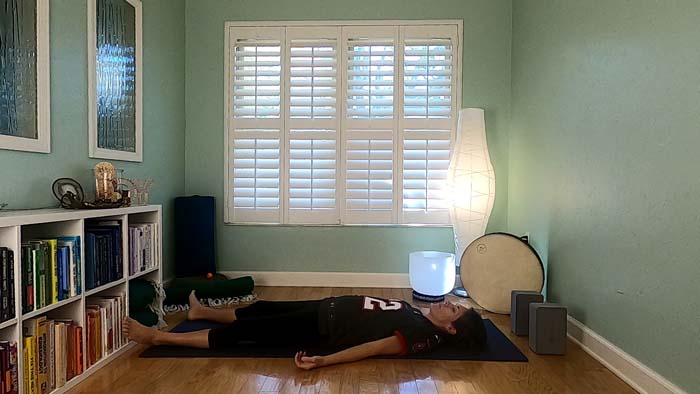
Purpose: Even though the latter half of this recovery yoga class has required less movement, it’s time to take total stillness and absorb the changes made in the practice. The time here can add more clarity to the mind. It can open up space in the body. Mostly, if rewrites the body to a new mind so that the operating system moving forward is more efficient, powerful, and aligned.
Length: 5-7 minutes
PUTTING IT TOGETHER
Life can be physically and mentally challenging, causing your body to function in sympathetic mode. This heightened awareness and boost of energy is great for athletes in competition. It can also help you meet high demands in your day. Yet you want to use yoga to reduce stress. This recovery yoga class will return you back to the rest-and-digest stage. The end result? A calm mind, nourished physical body, and balanced perspective from which to approach your training (and game-days) next time.
Take Action Now:
- Join me on the mat for this yoga class now.
- If you’re ready to learn how you can use yoga before, during and after your round of golf for better health and performance on the course, check out The Flexible Golfer program now.
